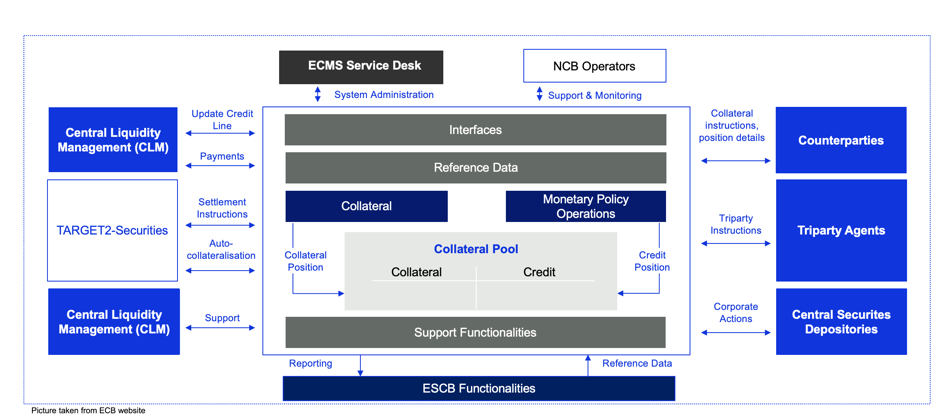
Consulting
European Collateral Management System. Adapting to the unified system for managing collateral in Eurosystem credit operations.
Written by Fanos Adams
Nov 3, 2021
European Collateral Management System (ECMS)
Adapting to the unified system for managing collateral in Eurosystem credit operations.
Turning implementation challenges to operational process efficiency.
The “Vision 2020” initiatives under the direction of the ECB serve to strengthen the market infrastructure of the Eurosystem, raise potential and further deepen the integration of the European financial market. In addition to TIPS and T2 / T2S consolidation, the ECMS (European Collateral Management System) is one of the migration projects that can be classified in the context of Vision 2020.
The go live of the ECMS was originally planned for November 2022, however, it was rescheduled due to the delay of the T2 / T2S consolidation project (Covid-19 pandemic) and the postponement of the SWIFT ISO 20022 migration in correspondent banking. The “big bang” implementation of the ECMS will also be moved to November 2023.
To ensure a smooth “big bang” migration, the national central banks of the euro zone will closely support the ECMS migration of their communities who currently have a monetary policy collateral account with them in a supervisory monitored process (community readiness monitoring). A Europe-wide harmonized milestone schedule developed by the ECB serves as a planning basis for all activities related to the migration of data and systems.
Objective of the ECMS

The aim of the ECMS project is to replace the 19 different collateral management systems (“Collateral Management Systems” – CMS) of the national central banks and to introduce a uniform system for the entire euro zone. Sufficient harmonization of underlying processes is a prerequisite for a uniform functional approach. With that in mind, the introduction of the ECMS will not only affect the euro zone banking sector but also CSDs (central securities depositories) and TPAs (triparty agents). After the Go-live of the ECMS communication with all TARGET services (T2 (consisting of CLM and RTGS), T2S, TIPS and ECMS) will be executed via the Eurosystem Single Market Infrastructure Gateway (ESMIG). This single gateway guarantees access to the ECMS for the community in a uniform and standardized way, so that they benefit from a simpler and more efficient procedure for the cross-border mobilization of collateral. However, the responsibility of the national central banks for their communities will remain unchanged. The ECMS will consist of core components (functionalities, services and processes) that have already been or harmonized or allow for further standardization at Eurosystem level.
Obligations of the national central banks
For some ECMS components, the respective national central bank can choose whether it wants to use the ECMS services or to continue with the national collateral management system for these parts. Non-harmonized functionalities, services and processes will not be part of the ECMS. However, the ECMS will largely replace the nationally operated applications for the administration of monetary policy collateral. Only the administration of credit claims will be handled by the national central banks as before via their national system.
Monetary policy peculiarities
In order to continue to participate in monetary policy operations, ECMS migration is mandatory. For full use of the ECMS, monetary policy business partners will need a new system access. Communication with the ECMS can take place U2A (user to application, i.e. via a graphical user interface) and / or A2A (application to application, i.e. via the exchange of messages in ISO 20022 format between systems). For technical communication, the use of an eligible network provider approved by the Eurosystem is mandatory for both U2A and A2A access. Business partners can either connect themselves to ECMS via ESMIG or use the technical access of a third party.
Outlook for banks, CSDs and TPAs in course of the ECMS Go-live
The counterparties affected by the ECMS migration (banks, CSDs & TPAs) are required to prepare early in order to ensure connectivity and communication with the ECMS for the Go-live. From this point on, queries and orders placed on the monetary policy collateral account, which is then managed in the ECMS, can only be initiated via ESMIG. The current access channels (e.g. for Germany Bundesbank-CAP or the previous form of SWIFT access) will no longer be available for this after the launch of ECMS. The current delivery channels for collateral can still be used, although settlement will generally take place in T2S.
The use of triparty systems will also be possible in the future. In order to be able to adequately check the connectivity and communication within the scope of the planned testing activities, which are carried out by the national central banks and the ECB in summer 2022, ECMS participants are now required to prepare their internal adaptations. The planned milestone, known as IAD5, starts in January 2022.
The cross-departmental implications for the procedural and organizational infrastructures should not be underestimated. In this context, the first banks are reporting that closer cooperation between the IT, treasury, cash and securities settlement as well as other affected functions for ECMS purposes is being promoted. In particular, the effects on liquidity management must be examined more closely at an early stage, since the available open credit line in the form of an essential parameter for managing intraday liquidity will be calculated in the ECMS and sent to the central liquidity management tool (CLM). Further feedback from practice highlights the positive effects that the ECMS migration brings with it. In this context, the first preliminary studies are being carried out to use the ECMS initiative as an opportunity to promote harmonization and optimization in the collateral management environment, which were long considered but never tackled in the past.
LPA Services
Our consultants were able to achieve significant results for our customers in the course of the first ECMS preliminary studies. The following services are in focus for banks, CSDs and TPAs:
- Evaluation of new ECMS ISO20022 messages as well as communication & connectivity requirements
- Support in adapting the relevant ECMS system landscape and operational processes, taking into account all affected areas, processes & systems
- Support in the implementation of specified milestones including preparation and follow-up of communication with supervision and documentation
- Preparation & implementation of test activities; incl. affected internal applications, test cases and documentation
- Collateral management optimization
[1] TIPS: Target Instant Payment Settlement[2] Triparty as a service provider who carries out all the collateral management related activities (collateral valuation, optimization, substitutions, settlement). Also relevant in the context of collateral but not to be confused with is the Third party, a manager/administrator values and selects the collateral and provides settlement instructions to a custodian, who carries out settlement, segregation and reporting activities.
Read more about TARGET T2/T2S Consolidation Project: Successful & timely adaption of the new TARGET platform here.
Authors

FANOS ADAMS
Fanos.Adams@L-P-A.com
Fanos Adams has over 7 years of consulting experience. She combines her experience in implementing supervisory driven initiatives with a distinct Capital Markets focus and a profound knowledge of the European banking domain.

DANIELA ROTHLEY
Daniela.Rothley@L-P-A.com
Daniela Rothley is a Partner in LPA´s Frankfurt-based consulting team. She has significant experience in the Capital markets arena and is LPA´s lead for many international banking clients and partners.

ALEKSANDRA MILIC
Aleksandra.Milic@L-P-A.com
Aleksandra Milic has over 10 years of experience within the Capital Markets area. She acquired profound knowledge of the European Market Infrastructure and post-trade services on projects at various European CSDs and financial institutions.

STEFAN WINGENBACH
Stefan.Wingenbach@L-P-A.com
Stefan Wingenbach has over 10 years of experience within the European banking sector. In his role as LPA´s subject matter expert for implementing Risk Management and Treasury solutions he is advisor to many European banking clients.
Authors

Fanos Adams
Manager Consulting , Germany
Fanos Adams has over 7 years of consulting experience. She combines her experience in implementing supervisory driven initiatives with a distinct Capital Markets focus and a profound knowledge of the European banking domain.

Stefan Wingenbach
Senior Manager, Germany
Stefan Wingenbach has over 10 years of experience within the European banking sector. In his role as LPA´s subject matter expert for implementing Risk Management and Treasury solutions he is advisor to many European banking clients.

Daniela Rothley
Partner, Germany
Daniela Rothley is a Partner in LPA´s Frankfurt-based consulting team. She has significant experience in the Capital markets arena and is LPA´s lead for many international banking clients and partners.

Aleksandra Milic
Consultant, Germany
Aleksandra Milic has over 10 years of experience within the Capital Markets area. She acquired profound knowledge of the European Market Infrastructure and post-trade services on projects at various European CSDs and financial institutions.

Elif Ercan
Senior Manager, Germany
Related News
Written by Sandro Schmid
Discover the Art of Generative AI
8 Mar, 2024
Written by Sophia Pfannes
Solving the Paradox Between AI Aspirations and Persistent Paper Requirements in Financial Documentation
21 Dec, 2023
Written by Sahak Artazyan
Navigating the Future of the Structured Products Market
21 Dec, 2023
Written by Gonzalo Plana
At the forefront of RegTech: a chat with Navin Sangtani, LPA’s Client Delivery expert
21 Dec, 2023
Written by Charles Kim-Régnier
Comparing Structured Products in Europe and Asia
21 Dec, 2023
Written by Julie Bradini
A Beginner’s Guide to Crypto and Blockchain in Structured Products
21 Dec, 2023